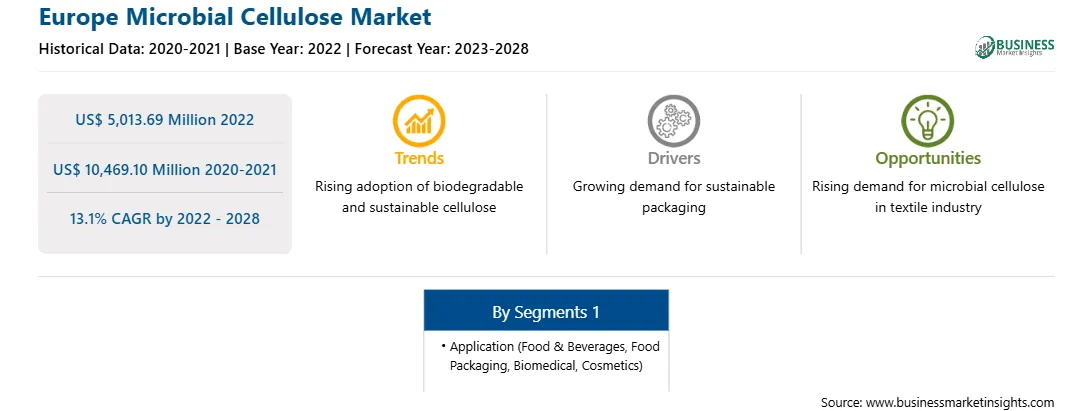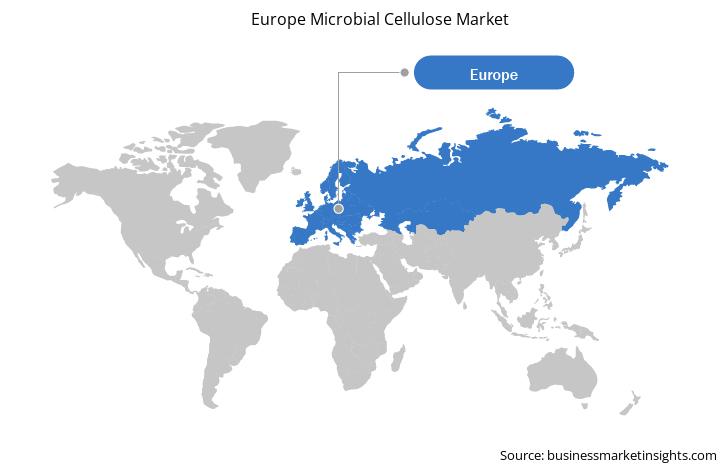Cosmetic manufacturers are exploring innovative approaches and materials to reduce environmental impact. Microbial cellulose is a natural and sustainable material praised by cosmetic manufacturers owing to its biocompatibility, skin adhesion, and water retention properties. Microbial cellulose is majorly used to make sheet masks used in skincare. These masks have superior moisture retention properties owing to their three-dimensional nanostructure that absorbs active hydrophilic ingredients such as antiageing agents and moisturizers. Bio-cellulosic face masks also have strong skin adhesion properties, which helps in better absorption or penetration of nutrients into the skin. Sheet masks made with petrochemical-based fiber are non-biodegradable and end up in landfills causing significant harm to the environment. Thus, as the cosmetics industry is moving toward sustainability, the adoption of natural, sustainable, and biodegradable sheet masks is increasing, which is boosting the demand for microbial cellulose across the industry. Further, people are seeking products that help them look youthful and fresh. They are willing to spend a tremendous amount on skincare products that make their skin healthy-looking and radiant. Sheet masks are getting immense traction among consumers as they help reduce fine lines, wrinkles, acne, and pigmentation; rejuvenate skin; and boost hydration. Considering the environmental impacts of petroleum-based nonwoven fiber sheet masks, consumers are preferring sustainable products in their daily skincare routines. All these factors are expected to boost the demand for microbial cellulose in the cosmetics industry during the forecast period.
The Europe microbial cellulose market is categorized into Germany, France, Italy, the UK, Russia, and the Rest of Europe. Microbial cellulose has proven to be a biomaterial and can be used in various applications, such as paper products, food & beverages, cosmetics, healthcare applications, and biomedical devices. The market growth in Europe is ascribed to a well-established personal care industry in European countries. The region is the world's largest cosmetics market with presence of well-established industry players. According to Cosmetic Europe, a vast majority of 500 million European consumers use cosmetic and personal care products daily to improve their well-being and boost skin nourishment. Bacterial cellulose is used as an emulsion stabilizer or an asset in face masks and skin treatments to deliver skin hydration and an active compound. In 2013, a cosmetic mask produced from microbial cellulose was patented by Amorepacific. Bacterial cellulose is a more sustainable alternative to traditional materials such as petroleum derivatives that are nonrenewable and difficult to degrade. Thus, manufacturers in the region are developing bio-based facial masks. For instance, in October 2020, Taiki Cosmetics Europe SAS launched a new ready-to-go sheet mask made in Europe, "N°4-Post Treatment Solution", a sustainable dried bio-cellulose sheet mask. Such product developments by manufacturers are anticipated to propel the market during the forecast period.
Strategic insights for the Europe Microbial Cellulose provides data-driven analysis of the industry landscape, including current trends, key players, and regional nuances. These insights offer actionable recommendations, enabling readers to differentiate themselves from competitors by identifying untapped segments or developing unique value propositions. Leveraging data analytics, these insights help industry players anticipate the market shifts, whether investors, manufacturers, or other stakeholders. A future-oriented perspective is essential, helping stakeholders anticipate market shifts and position themselves for long-term success in this dynamic region. Ultimately, effective strategic insights empower readers to make informed decisions that drive profitability and achieve their business objectives within the market. The geographic scope of the Europe Microbial Cellulose refers to the specific areas in which a business operates and competes. Understanding local distinctions, such as diverse consumer preferences (e.g., demand for specific plug types or battery backup durations), varying economic conditions, and regulatory environments, is crucial for tailoring strategies to specific markets. Businesses can expand their reach by identifying underserved areas or adapting their offerings to meet local demands. A clear market focus allows for more effective resource allocation, targeted marketing campaigns, and better positioning against local competitors, ultimately driving growth in those targeted areas.Europe Microbial Cellulose Strategic Insights

Europe Microbial Cellulose Report Scope
Report Attribute
Details
Market size in 2022
US$ 5,013.69 Million
Market Size by 2028
US$ 10,469.10 Million
Global CAGR (2022 - 2028)
13.1%
Historical Data
2020-2021
Forecast period
2023-2028
Segments Covered
By Application
Regions and Countries Covered
Europe
Market leaders and key company profiles
Europe Microbial Cellulose Regional Insights

Europe Microbial Cellulose Market Segmentation
The Europe microbial cellulose market is segmented based on application and country. Based on application, the Europe microbial cellulose market is segmented into food & beverages, food packaging, biomedical, cosmetics, and others. The food & beverages segment held the largest market share in 2022.
Based on country, the Europe microbial cellulose market is segmented into Germany, the UK, France, Italy, Russia, and the Rest of Europe. The Rest of Europe dominated the Europe microbial cellulose market share in 2022.
Ashland Inc; Bacpolyzyme Biyomuhendislik Ltd; BIOINSPIRED MATERIALS SL; Bioweg UG; BOWIL Biotech SP Zoo; Polybion SL; and ScobyTec GmbH are the leading companies operating in the Europe microbial cellulose market.
The Europe Microbial Cellulose Market is valued at US$ 5,013.69 Million in 2022, it is projected to reach US$ 10,469.10 Million by 2028.
As per our report Europe Microbial Cellulose Market, the market size is valued at US$ 5,013.69 Million in 2022, projecting it to reach US$ 10,469.10 Million by 2028. This translates to a CAGR of approximately 13.1% during the forecast period.
The Europe Microbial Cellulose Market report typically cover these key segments-
The historic period, base year, and forecast period can vary slightly depending on the specific market research report. However, for the Europe Microbial Cellulose Market report:
The Europe Microbial Cellulose Market is populated by several key players, each contributing to its growth and innovation. Some of the major players include:
The Europe Microbial Cellulose Market report is valuable for diverse stakeholders, including:
Essentially, anyone involved in or considering involvement in the Europe Microbial Cellulose Market value chain can benefit from the information contained in a comprehensive market report.